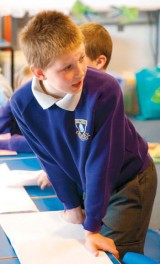If your boys are looking bored, discover their strengths and use them to plan high quality learning for the whole class...
Do you have boy trouble (in your class that is)? How many of these words apply: disengaged, disruptive, funny, charming, roguish, disaffected, fidgety, loud, aggressive, loveable, hyper-fair, hyper-right, hyper-helpful and plain hyper? I exhibited several of these qualities at school and developed others at university. But I also worked hard, played hard and did not usually come across as a ‘typical boy’. And here lies a warning: ‘boys’ is a very big group. It comprises a whole bunch of unique personalities with diverse learning needs. What’s right for Adam might not suit Ben; Chris’ learning style could really switch off Darren. (But it might engage Debbie and Erin…)
I asked whether you had boy trouble. I could have said dyslexia trouble, or girl trouble, or EAL trouble, or poor working class pupil but with phenomenally good memory trouble. The name of your target group is not a limitation (‘they’re boys, what do you expect?’) or a label (‘of course, all boys behave like this’). However, the naming of a target group will draw the best from you. You are challenged to understand individual needs and plan for them. This process is called good teaching and if you do it for one group, then you can do it for any group.
So with that in mind, what might engage our (troublesome?) boys with their learning?

At three weeks in-utero everyone is female. Then a testosterone surge nudges some foetuses in the male direction. When this happens, the tiny brain and body set off growing in different ways. Some more obvious than others. From then on a boy’s growth is beholden to waves of testosterone crashing over his genetic and evolutionary heritage. In the womb he’ll be more likely to develop dyslexia and autism; his two brain halves being less well connected than a girl’s. In the maternity ward he’ll pay more attention to moving objects than to faces. At school he’ll want to talk and move rather than sit and listen and write. And in the playground (thanks to his cave ancestors) he’ll have a strong sense or hierarchy, roles and pecking order.
Combine the brain science, the educational research and your own working knowledge and you’ll get a pretty good picture of (some) boys’ learning preferences. The trick is to match these preferences to high quality learning activities. For example, if your boys need competition, humour and movement then plan a writing activity that includes all three.
Here are six generic activities that play to the boys yet can include everyone.
A large group or whole class team building activity
• The ‘time tunnel’ is either a plastic PE hoop or a small loop of thick elastic.
• Set the game rules for either whole class (one tunnel) or larger groups (one tunnel per group):
• You must have a timekeeper and a leader for this task
• Everyone must go completely through the time tunnel once only
• As each person goes through the tunnel, their name must be called together with one past achievement
• You have 15 minutes to work out the fastest way to do this and when time’s up demonstrate it
• Debrief by asking: How did you do it? Was it the fastest solution? Did everyone get to put an idea forward? Did everyone feel included? How could we improve? What’s our target time?
• Write down suggestions for improvement and repeat the activity later in the week.
A high pressure, small team activity for recalling key facts
• Place multiple copies of the material to be learned (poem, spellings, tables, a photograph or artefact, etc.) outside the
classroom – where they must stay.
• Put children into teams of three and allocate roles A, B and C.
• Tell the class that the teams are going to compete to create the best copy of what’s outside the classroom.
• Signal all the As to leave and take a look at the material outside the classroom, remembering as much detail as they can.
• When the As return, they talk to their Bs and Cs and begin to make a copy of the material.
• Signal all the Bs to leave, look at the material, remember more detail, and return.
• Cs have a go and then As, Bs and Cs all get another turn.
• The copying ceases. As retrieve the material and compare it to the team’s copy.
• Discuss strategies and communication and then ask groups to justify why their copy is the best.
 An individual or paired thinking skills activity
An individual or paired thinking skills activity
• Create sets of 16 small cards, each bearing a different keyword or topic concept (e.g. geographical features, spelling words, materials, sports, instruments).
• Children place the cards in a 4 X 4 grid.
• The challenge is to make creative connections between neighbouring cards.
• This can be repeated without the 4 X 4 restriction or as a turn taking game – each card must be creatively linked to the previous one played.
• Challenge pupils to make a different connection for every pair of neighbouring cards – horizontal, vertical or diagonal.
• Debrief by asking what other sets of cards could be created? Words? Images? Sounds? Objects?
A creative yet structured way to begin lessons
• Find an image related to your objective (try image Googling the exact words in your learning objective). Funny is good.
• Display the image at the start of the lesson.
• Give individuals one minute to write down a sentence about the image.
• Then give pairs two minutes to share their sentences and create a better one.
• Finally, give groups of pairs (4s, 6s etc.) three minutes to share their sentences and come up with an even better one.
• Groups feed back their sentences which then leads into the main activity.
A whole day scenario project in which mysterious alien eggs have been found in school
This is inspired by two great ideas from UK schools (everybodywrites.org.uk/projects). It requires a lot of planning and buy-in from staff and parents, yet can can offer great rewards – especially for boys’ engagement with writing.
 • Choose a day and invent a scenario in which mysterious alien eggs have appeared overnight in one part of the school.
• Choose a day and invent a scenario in which mysterious alien eggs have appeared overnight in one part of the school.
• Plan the day, create the eggs and other artefacts and brief involved adults (for role-play).
Events during the day might include:
• The media appear and need your help
• Scientists appear and need your help
• Mysterious visitors appear and start snooping
• The eggs vanish then reappear
• Select children are invited to view the eggs
• Something escapes from an egg
• Sounds start to come from an egg
• All electricity is momentarily turned off
Activities during the day might include:
• Write questions to the eggs and receive answers
• Draw what might be inside
• Speculate about where they came from
• Debate what to do with the eggs
• Create a language to communicate with the aliens
• Create a plan to defend the school from alien invasion
• Measure the eggs – weight/volume/mass
• Keep a written/audio/video diary of the day
Reveal all at the end of the day (or the following day if you want some focused homework).
Throughout, be sensitive to children’s potential fears and anxieties. But exploit their imaginations, curiosity and sense of wonder.
Mike Fleetham is a respected educational consultant and trainer who has worked with hundreds of schools in the UK and abroad. His Thinking Classroom concept and associated website and books have inspired thousands of educators. Download further resources for free at http://www.thinkingclassroom.co.uk
This is a list of factors that can make lessons more appealing to some male pupils. which do you believe will (re-) engage your boys? all of the activities in this article include different combinations of the following.
• Competition
• Teamwork
• Team roles
• Movement
• Working alone
• Handling
• Structure
• Short tasks
• Humour
• Images
• Talking
• Thinking
• Creating
• Rules
• Freedom
• Risk
• Achievement
• Self-esteem
Collect sticks and materials to tie to, hang off and stick to them. Choose a focus or a story and ask children to fix things to their sticks to represent key features of this. Ask children to retell the learning or the story using only the memory stick.
Experts are forever tussling over how much time our kids spend in front of technology vs. running about outside. The debate is magnified for boys who are stereotypically more active and more interested in computers. It’s not either/or but both. Boys will be drawn to technology. We do them a disservice to deprive them of the latest kit. However, boys will also be drawn to sticks and dens and hiding in the forest. And likewise we do them an equal disservice to deprive them of outdoor opportunities. So look for examples of outdoor technology. Star Walk for the iPad, which overlays constellation information when pointed to the sky, is a perfect example.
 How to build effective learning relationships…
How to build effective learning relationships…
All good teaching relies on a strong relationship between teacher and pupil. Mutual understanding and effective communication are bedrocks of learning. Keep the following in mind for a boy:
• Engage with his sense of humour
• Protect his pride
• Maintain his self-esteem
• Let him know where he stands
• Offer simple clear instructions, with reasons
• Now and again, do try to out-charm him
• Listen to him and hear him
• Let him know a little about you…
Easy ways to combat teacher stress
Ace-Heads
How children react to a moral dilemma may be down to your teaching
Ace-Classroom-Support
